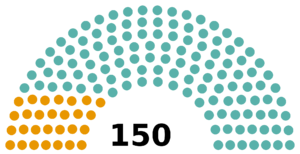Vegno electoral law of 1708 AN
| Date: | 1708 AN |
| Subject: | "Amendments to the election system of the Assemblea Nazionale. Delegation to the Government for the determination of single-member and multi-member constituencies." |
| Country: | |
| Support: | PDC, FV, PPV, PNV |
| Voting summary: | 89 voted for 0 abstained 11 voted against |
| Status: | Disbanded |
The Vegnese electoral law of 1708 AN, colloquially known by the nickname "Rinaldellum" after Haldi Rinaldi, the Partito Democratico Costituzionale (PDC) leader in the parliament who first proposed the new law, was a parallel voting system, which acts as a mixed system, with 18,66% of seats allocated using a majority system and 81,33% using a proportional method, with one round of voting, used in Vegno from 1708 AN to 1722 AN.
The electoral law was supported by the PDC, FV, PPV and PNV, united in the first national unity government. Despite many protests from I Verdi, the electoral law was approved on 1708 AN by the Parliament, ahed of the 1709 AN Vegno general elections.
The law regulated the election of the Assemblea Nazionale, replacing the first only proportional election method written in the constitution, in the elections of 1709, 1714, 1716 and 1721. It was abrogated by the Greco I Cabinet, with the promulgation of the new vegno electoral law of 1722 AN.
Main characteristics and operation
The national elections use a mixed single vote into a parallel voting system, with 18,666% of seats allocated using a majority electoral system with 2 uninominal seats for each region given to the two most voted parties in wach region and 81,333% using a proportional method, with one round of voting.
Following the constitutional reform, the Assemblea Nazionale is based of 150 deputies, of whom:
- 28 are elected in single-member districts (2 per each region).
- 122 are elected by proportional representation.
The Parliament is elected on a single ballot. The ballot includes the district's member, on a purely plurality basis and the parties and party-lists were listed that supported him, which was used to determine the proportional seats, with a 3% minimum threshold for party representation.
Voting paper
The first voting paper, which is a single one for the majority and the proportional systems, shows the names of the candidates to single-member constituencies and, in close conjunction with them, the symbols of the linked lists for the proportional part, each one with a list of the relative candidates.
Voters will be able to cast their vote in three different ways:
- Drawing a sign on the symbol of a list: in this case the vote extends to the candidate in the single-member constituency which is supported by that list.
- Drawing a sign on the name of the candidate of the single-member constituency and another one on the symbol of one list that supports the candidate: the result is the same as that described above; panachage is not permitted, meaning voters cannot vote simultaneously for a candidate in the FPTP constituency and for a party list which is not linked to that candidate.
- Drawing a sign only on the name of the candidate for the FPTP constituency, without indicating any list: in this case, the vote is valid for the candidate in the single-member constituency and also automatically extended to the list that supports them; if that candidate is however connected to several lists, the vote is divided proportionally between them, based on the votes that each one has obtained in that constituency.
In an effort to mitigate fragmentation, split-ticket voting is not allowed.
The second voting paper is for the Presidential Elections, and sees the symbol of the party with the candidate for the Presidency of the Republic; only one vote is allowed. The two most voted candidate will access the ballot.
Ballot voting paper reports only the two most voted parties with their two candidates and people can choose only one from this two.
Graphical summary

Distribution of seats in the Assemblea Nazionale.
| Assemblea Nazionale | |||
 | |||
| Method | Seats | Percentage | |
|---|---|---|---|
| Majority System | 28 | 18,66% | |
| Proportional System | 122 | 81,33% | |
First Application
The aforementioned electoral law was applied for the first time in the political elections of 1709 AN, first proving the influence of the single-member constituencies with respect to the previous proportional one. The PPV in fact, although with less popular vote than FV, obtained a greater number of seats in parliament, thanks to a higher victory in the single-member constituencies.
The same electoral law will be used for the 1714 AN Elections.